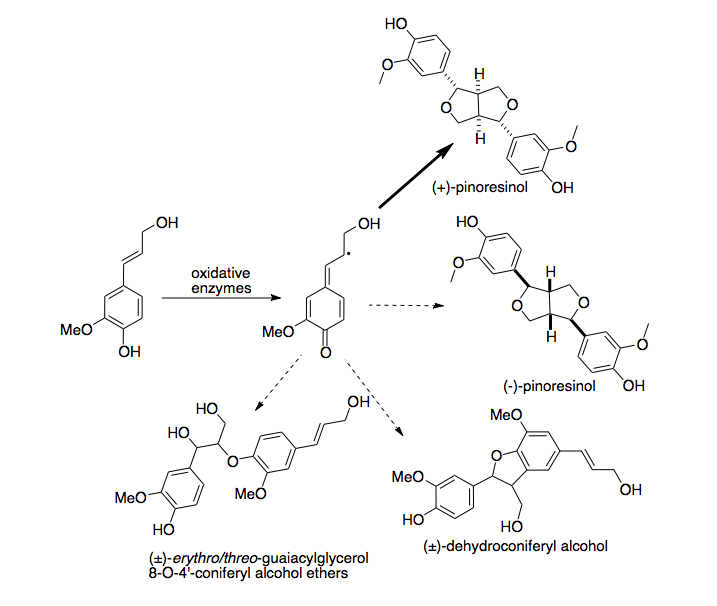pinoresinol on:
[Wikipedia]
[Google]
[Amazon]
Pinoresinol is a tetrahydrofuran


lignan
The lignans are a large group of low molecular weight polyphenols found in plants, particularly seeds, whole grains, and vegetables. The name derives from the Latin word for "wood". Lignans are precursors to phytoestrogens. They may play a role ...
found in ''Styrax
''Styrax'' (common names storax or snowbell) is a genus of about 130 species of large shrubs or small trees in the family Styracaceae, mostly native to warm temperate to tropical regions of the Northern Hemisphere, with the majority in eastern ...
sp.'', ''Forsythia suspensa
''Forsythia suspensa'', commonly known as weeping forsythia or golden-bell, is a species of flowering plant in the family Oleaceae, it is native to China.
Taxonomy
The Latin epithet of ''suspensa'' is derived from ''suspensus'' meaning suspend ...
, and in Forsythia koreana''. It is also found in the caterpillar of the cabbage butterfly, ''Pieris rapae
''Pieris rapae'' is a small- to medium-sized butterfly species of the whites-and-yellows family Pieridae. It is known in Europe as the small white, in North America as the cabbage white or cabbage butterfly, on several continents as the small ca ...
'' where it serves as a defence against ants.
In food, it is found in sesame
Sesame ( or ; ''Sesamum indicum'') is a flowering plant in the genus ''Sesamum'', also called benne. Numerous wild relatives occur in Africa and a smaller number in India. It is widely naturalized in tropical regions around the world and is cu ...
seed, in ''Brassica
''Brassica'' () is a genus of plants in the cabbage and mustard family (Brassicaceae). The members of the genus are informally known as cruciferous vegetables, cabbages, or mustard plants. Crops from this genus are sometimes called ''cole cr ...
'' vegetables and in olive oil
Olive oil is a liquid fat obtained from olives (the fruit of ''Olea europaea''; family Oleaceae), a traditional tree crop of the Mediterranean Basin, produced by pressing whole olives and extracting the oil. It is commonly used in cooking: f ...
. Pinoresinol has also been found to be toxic to larvae of the milkweed bug Oncopeltus fasciatus and of the haematophagous insect Rhodnius prolixus, which is a vector of chagas disease.
Currently, pinoresinol is isolated from plants with low efficiency and low yield.
Biosynthesis
A firstdirigent protein Dirigent proteins are members of a class of proteins which dictate the stereochemistry of a compound synthesized by other enzymes. The first dirigent protein was discovered in ''Forsythia intermedia''. This protein has been found to direct the stere ...
was discovered in ''Forsythia intermedia
''Forsythia'' , is a genus of flowering plants in the olive family Oleaceae. There are about 11 species, mostly native to eastern Asia, but one native to southeastern Europe. ''Forsythia'' – also one of the plant's common names – is ...
''. This protein has been found to direct the stereoselective biosynthesis
In chemistry, stereoselectivity is the property of a chemical reaction in which a single reactant forms an unequal mixture of stereoisomers during a non- stereospecific creation of a new stereocenter or during a non-stereospecific transformation o ...
of (+)-pinoresinol from coniferyl alcohol
Coniferyl alcohol is an organic compound with the formula HO(CH3O)C6H3CH=CHCH2OH. A colourless or white solid, it is one of the monolignols, produced via the phenylpropanoid biochemical pathway. When copolymerized with related aromatic compounds, ...
monomers. Recently, a second, enantiocomplementary dirigent protein Dirigent proteins are members of a class of proteins which dictate the stereochemistry of a compound synthesized by other enzymes. The first dirigent protein was discovered in ''Forsythia intermedia''. This protein has been found to direct the stere ...
was identified in ''Arabidopsis thaliana
''Arabidopsis thaliana'', the thale cress, mouse-ear cress or arabidopsis, is a small flowering plant native to Eurasia and Africa. ''A. thaliana'' is considered a weed; it is found along the shoulders of roads and in disturbed land.
A winter a ...
'', which directs enantioselective synthesis of (-)-pinoresinol.

Pharmacology
Pinoresinol inhibits the enzymeα-glucosidase
Glycoside hydrolases (also called glycosidases or glycosyl hydrolases) catalyze the hydrolysis of glycosidic bonds in complex sugars. They are extremely common enzymes with roles in nature including degradation of biomass such as cellulose (cel ...
''in vitro
''In vitro'' (meaning in glass, or ''in the glass'') studies are performed with microorganisms, cells, or biological molecules outside their normal biological context. Colloquially called "test-tube experiments", these studies in biology an ...
'' and may therefore act as a hypoglycemic
Hypoglycemia, also called low blood sugar, is a fall in blood sugar to levels below normal, typically below 70 mg/dL (3.9 mmol/L). Whipple's triad is used to properly identify hypoglycemic episodes. It is defined as blood glucose belo ...
agent. A study involving extra virgin olive oil
Olive oil is a liquid fat obtained from olives (the fruit of ''Olea europaea''; family Oleaceae), a traditional tree crop of the Mediterranean Basin, produced by pressing whole olives and extracting the oil. It is commonly used in cooking: f ...
showed that pinoresinol possess ''in vitro'' chemoprevention properties. Increased apoptosis and cellular arrest at the G2/M stage in p53-proficient cells occurred. Pinoresinol of olive oil decreases vitamin D intestinal absorption.
Metabolism into enterolignans
Pinoresinol, along with other plant lignans, are converted intoenterolignan Enterolignans are organic compounds formed by the action of gut microflora on lignan
The lignans are a large group of low molecular weight polyphenols found in plants, particularly seeds, whole grains, and vegetables. The name derives from the L ...
s by intestinal microflora in the human body.
See also
*List of phytochemicals in food
While there is ample evidence to indicate the health benefits of diets rich in fruits, vegetables, legumes, whole grains and nuts, no specific food has been acknowledged by scientists and government regulatory authorities as providing a health bene ...
References
{{lignan Lignans